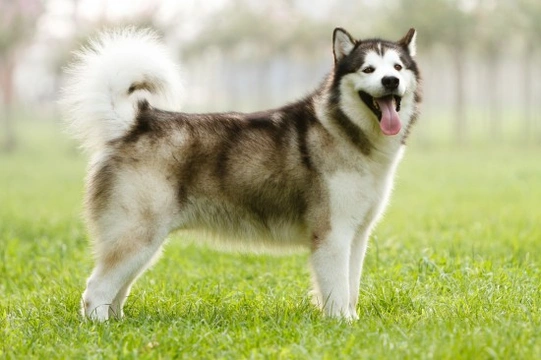
Common Health Issues in the Alaskan Malamute: What You Need to Know
The Alaskan Malamute is known for its strength and endurance, with many enjoying a healthy lifespan of around 11 to 12 years. However, like many pedigree dogs, Alaskan Malamutes are prone to specific hereditary and acquired health conditions that owners should be aware of to ensure timely care and a better quality of life.
Understanding and recognising early signs of these health issues can greatly improve treatment outcomes. Responsible breeders focus on genetic testing and careful selection to reduce many risks, so it’s important to find a reputable breeder if you decide to bring a Malamute puppy home.
1. Hip Dysplasia
This common orthopedic condition arises when the hip joint develops abnormally during growth, causing pain and impaired mobility often leading to arthritis. Active and large breeds like the Alaskan Malamute are especially susceptible. Early veterinary diagnosis via hip screening allows management strategies such as weight control, pain relief, and sometimes surgery to improve comfort and function.
2. Chondrodysplasia
A genetic disorder affecting cartilage development, chondrodysplasia can result in dwarfism or skeletal deformities such as bowed legs. Though the condition is lifelong, many dogs live normal lives. Genetic testing is vital to avoid breeding affected dogs.
3. Inherited Polyneuropathy (Alaskan Malamute Polyneuropathy)
This neuromuscular disorder typically manifests in young dogs, causing muscle weakness, loss of coordination, and sometimes voice changes. While there’s no cure, supportive care such as physiotherapy and adaptive measures can help maintain quality of life.
4. Blood Clotting Disorders: Haemophilia A, Haemophilia B, and von Willebrand Disease
Male dogs can be affected by haemophilia A and B, disorders that impair normal blood clotting, risking uncontrollable bleeding. Female carriers should not be bred to prevent transmission. Von Willebrand Disease similarly impairs clotting and can cause bleeding episodes. Responsible breeders test for these conditions to minimise risk.
5. Hypothyroidism
This common endocrine disorder occurs when the thyroid gland doesn’t produce enough hormone, leading to symptoms like weight gain, lethargy, skin problems, hair loss, and behavioural changes. Fortunately, it is manageable with daily medication and routine vet monitoring to maintain your Malamute’s wellbeing.
6. Progressive Retinal Atrophy (PRA)
PRA is a hereditary eye condition causing gradual vision loss, potentially leading to blindness. Regular annual eye examinations by a vet are crucial to monitor progression and explore treatment options. Early detection helps manage and prepare for vision changes.
7. Osteochondritis Dissecans (OCD)
OCD involves improper cartilage development in joints, often affecting elbows and shoulders, leading to stiffness and pain. It can start in puppies as young as four months and may be linked to nutrition and growth rate. Treatment can range from diet management to surgical correction, following veterinary advice.
8. Corneal Dystrophy
An inherited eye disorder affecting the cornea, corneal dystrophy causes cloudiness that can impair vision. While often not painful, it requires monitoring and veterinary care to prevent complications.
9. Glaucoma
A painful ocular condition where increased eye pressure can cause blindness if untreated. Prompt veterinary action is essential to relieve discomfort and prevent permanent damage.
10. Cataracts
Alaskan Malamutes are more prone to cataracts compared to some related breeds. This causes clouded lenses and vision impairment. Regular vet eye checks can detect cataracts early, and surgical removal can restore sight in many cases.
11. Diabetes Mellitus
This metabolic disease causes insufficient insulin production leading to issues like increased thirst and urination. Management requires a special diet, insulin injections, and careful exercise routines to optimise health.
12. Pituitary Dwarfism and Narcolepsy
Pituitary dwarfism causes lifelong skeletal and growth issues, often requiring tailored veterinary treatment depending on the underlying cause. Narcolepsy affects the nervous system, leading to sudden sleep episodes; although not life-threatening, it requires attention to ensure safe management.
Why Responsible Breeding and Regular Vet Care Matters
Choosing a reputable breeder who performs health screenings can greatly reduce the likelihood of hereditary diseases. Regular veterinary check-ups including eye examinations, joint screenings, thyroid testing, and blood work ensure early diagnosis and improve treatment success.
Maintaining a balanced diet, proper exercise, and grooming supports your Malamute’s health and happiness. Staying informed about potential health concerns empowers you as a responsible and caring owner.
Conclusion
The Alaskan Malamute is a strong and resilient breed, yet aware owners understand they need diligent care to navigate common health challenges. By prioritising early symptom recognition, collaborating with your vet, and choosing ethically bred puppies, you can enjoy many joyful years with your affectionate and loyal companion.



